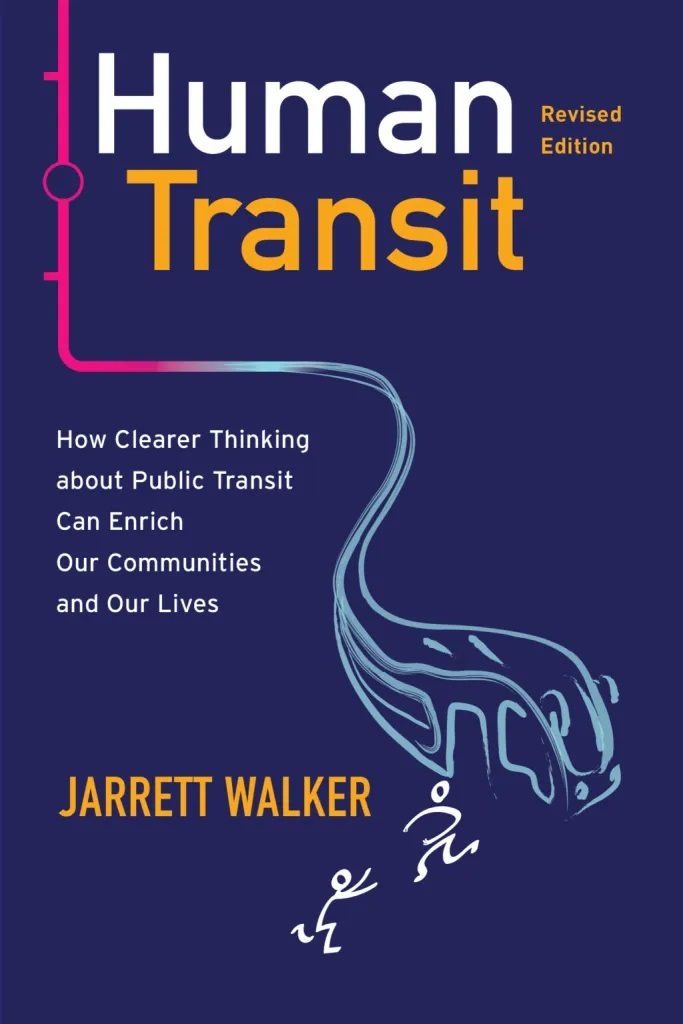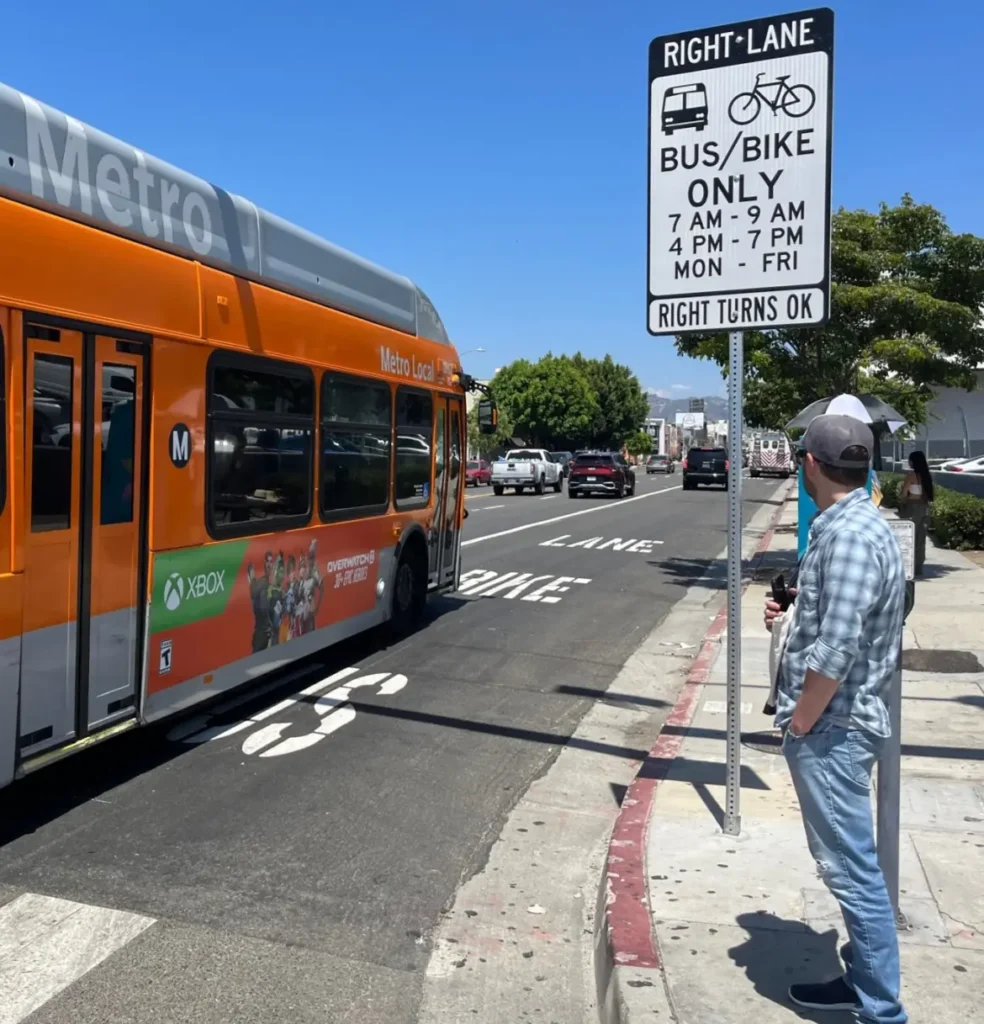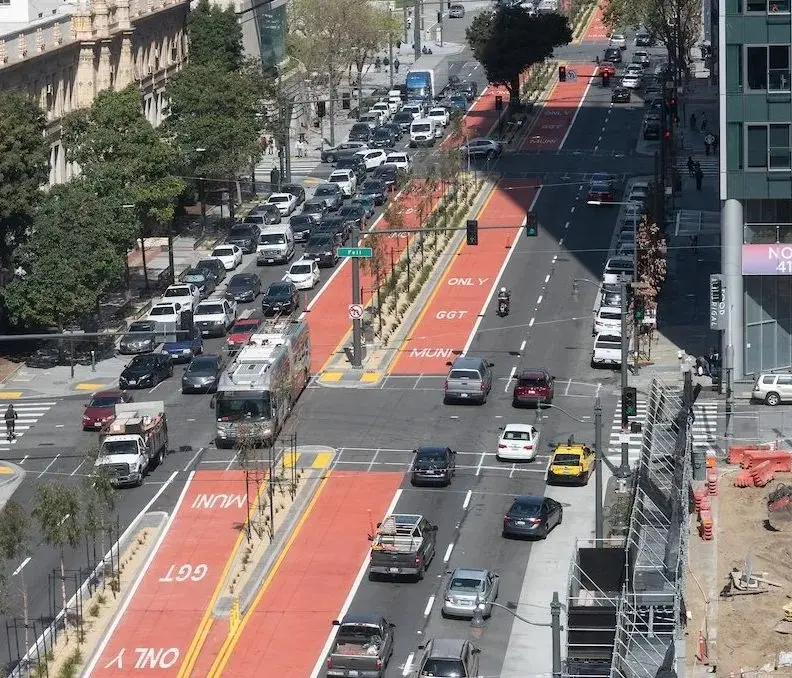Streetsblog caught up with Jarrett Walker during his recent visit to Southern California.
Walker’s name is familiar to many Streetsblog readers. He and his firm, Jarrett Walker and Associates, are the strategists behind of numerous successful bus network redesigns, which inspired Metro’s NextGen bus service retool.
Walker is the author of the book Human Transit, long an invaluable resource for anyone interested in making transit work. In language accessible to non-experts, Walker explains frequency, coverage, trade-offs, technology, and much more. One of his key tenets is “frequency is freedom.” Frequent buses provide the most useful service, and correlate to higher ridership.

Earlier this year, Island Press published the revised edition of Human Transit. Read Streetsblog USA’s Walker interview commemorating the new edition.
This interview took place in person in downtown L.A. in April. It has been lightly edited for readability.
SBLA: Could you share your take on choice vs. captive riders? I am a fan of your advice to transit agencies that choice/captive is a myth, and instead “focus on the middle 90 percent.” What’s wrong with the choice / captive dichotomy?
Jarrett Walker: For many decades – most of my career – transportation professionals have talked about there being something called a “choice rider”: someone who has a car and chooses to use transit instead of using their car. And the opposite of a choice rider is a “dependent rider,” or to use an even worse word… a “captive rider”: someone who is presumed to not have a choice about using transit.
The idea that the population can be absolutely divided into these two categories is something that actually goes back to very primitive transportation models from many decades ago, before they had the CPU necessary to do sophisticated modeling. But it has stuck in the popular consciousness that there is this thing called a choice rider – and because that’s the person who is making choices, that’s the person that transit should be focusing on.
I am here to say that all of that is nonsense.
Almost everyone has some reasons not to drive. Plenty of people who own cars – people like me – don’t like driving. [They] dislike the danger, the stress. Many people own unreliable cars they would rather not rely on.
Then there are many people who don’t own cars but who do have some options – who can get rides with family and friends, and find other ways to arrange their transportation.
The point is that almost everyone is in the middle. Sort of choice and sort of captive. And the people we are most likely to attract onto transit are very definitely in the middle. They’re people who may not have a reliable car at home, but nevertheless we still have to earn their business by providing a useful service. By useful, I mean something that takes them where they’re going in an amount of time they have in their day.
In many cases, the focus on the choice rider has led us away from that. It has led us into an obsession with what kind of transit service relatively elite people will respond to.
I think that’s a dead end because they aren’t enough of those elite people to really matter. What we really need to do is focus on what I like to call the “middle 90 percent,” who are not elite in their tastes – who do want something that’s decent, who want something that’s a good use of their time, who will use the service if it’s useful to them.
Let’s get your take on some things that Southern California is doing to help make transit more effective.
Metro and the city have done about thirty lane-miles of new bus lanes in the last half-decade. I think they’re great, though some drivers park in them, so they’re not as effective as they might be. What’s your take on bus lanes?

Bus lanes that are operating with the flow of traffic and that have a row of parked cars to the right of them are always going to experience all kinds of friction associated with cars turning, cars going in and out of those parking spaces.
There is also always the option of a proper median busway such as San Francisco has built on Van Ness Avenue. That’s pretty much the best example in California of a really high-functioning median busway.

That was a six lane arterial; it had three traffic lanes in each direction and parking lanes. Slightly wider than your average Los Angeles boulevard, but there are plenty of Los Angeles boulevards that are that wide.
Center-running BRT [Bus Rapid Transit] is great. Although you have to cross the street to it from either side, you’re going to have to cross the street anyway to complete a round trip. Median operation just has no interference with parallel traffic at all, so it’s much more reliable.
I think L.A. is going to have to think about center-running – at least for some of your wider boulevards.
Downtown, where I’ve been staying, I’ve been surprised to see a pattern of the buses still being spread out across almost every north-south street. What many other cities have done in that situation is to do the very difficult political work of choosing a pair of north-south streets to put all the buses on. Create double-width bus lanes there that flush huge amounts of buses through.
A double-width bus lane has three times the capacity of a single-width bus lane. So it’s a very efficient way to move large numbers of buses through.
Of course it’s an enormous difficult decision. But Portland did this in 1978 and Minneapolis did this in 2007 – created those double-width bus lanes that were contraflow – that is to say you did not have traffic flowing in the same direction by and large – and, as a result, quite nicely protected from traffic and with the ability to move lots of buses through.
I’ve been going back and forth to El Monte so I’ve been on the J Line and the Silver Streak. The process of getting into downtown, it’s multiple turns to get into the Grand Olive couplet and then not really having much priority there.
I wish there had been a more courageous effort to really – and I have to admit I don’t know the history, maybe there was a courageous effort – but I wish there had been an effort to pick the street that transit would really focus on and then get transit right there.
How about all door boarding? It’s something Metro has piloted, and it’s actually in this year’s budget to expand.
It’s normal. San Francisco has done it. There’s nothing different about San Francisco that should lead you to believe you’d get different outcomes here. The debate is over in San Francisco; it was done years ago – several years ago.
How proven is it for speeding up boarding?
They saved a lot of time. A lot of time. You can contact them and get the actual information, but they save a lot of dwell time. With a TAP card you should be able to board all doors everywhere. It’s an enormous waste of time to bring people all in through one door.
It’s been frustrating that many Metro bus lane/BRT projects experience long delays. Any tips on getting quick-build bus projects built quickly?
Van Ness was certainly not quick-build. San Francisco does a lot of branding around the number 49 – the 49ers and all that. As it turns out, it was 49 years from the adoption of the Transit First ordinance in 1973 to actually fix Van Ness, right outside of city hall – the city supervisors have a view of it – in 2022.
It took 49 years for them to finally open that lane.
Part of the problem, of course, is that center-running BRT is a big capital project. Side bus lanes do not have to be massive capital projects; it’s just some paint and some signs and maybe some curb. It’s a more gentle shift in the operations of the street.
So obviously the whole world is jumping up and down and applauding the passage of Measure HLA here. I am assuming now we’re going to see those sorts of informal bus lanes all over the place now. I certainly hope so.
But I think you’ll find that side bus lanes are a good start, but that, at some point, you may still want to look at proper center-running to really get the BRT effect.
Any other suggestions for L.A. transit? If you were in charge here, what sort of changes would you make?
I think you have the potential to have one of the simplest and most legible transit systems anywhere, because you’re a city of big long boulevards that the buses mostly follow.
You really want to encourage the attitude that the bus is an intrinsic part of the street. If you’re in West Hollywood, you should be able to just say “yeah – take La Cienega down to Venice, hang a right and go out.” Those are the driving directions, but those should also be the transit directions. It should be that simple. There’s La Cienega so there’s a La Cienega bus. There’s Venice Boulevard so there’s a Venice Boulevard bus, and it’s that easy.
I think Metro could go further in making the system that legible.
But it’s already certainly much improved. I first arrived in this region as an undergraduate in 1980 in Claremont. It was nearly a complete wasteland of transit at that time. Obviously in all these years I’ve seen a lot of improvement.
I still think that there are lots of possibilities for making the bus feel like a more intrinsic part of each major street it operates on, rather than a thing that happens on the street. So I think there’s some potential there.
For more Jarrett Walker, watch the video of his April 18 talk at UCLA’s Institute for Transportation Studies.
